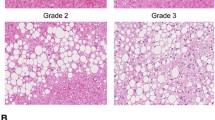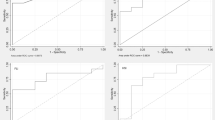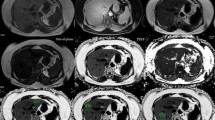Abstract
Background
Currently, the standard procedure used to evaluate hepatic steatosis is the liver biopsy. This is an invasive practice that presents inherent risks. Increasing evidence suggests that magnetic resonance imaging (MRI) and MR spectroscopy (MRS) may represent an accurate method to determine the hepatic lipid content. The aim of this study was to evaluate the effect of sleeve gastrectomy on liver steatosis, quantified by MRI and MRS.
Patients and Methods
A prospective observational study of patients undergoing laparoscopic sleeve gastrectomy was performed. All patients underwent a MRI and a MRS study 2 weeks before the intervention and 6 months after the surgery. Anthropometric, biochemical, and radiological parameters were analyzed.
Results
Twenty-three patients were included, 21 females and 2 males, with a mean age of 47.6 ± 10.6 years and mean pre-op BMI 47.6 ± 6.7 Kg/m2. Six months after surgery, mean BMI was 32.2 ± 5.1 Kg/m2, with a mean excess weight loss of 68.2 ± 18.6%. Mean preoperative hepatic volume was 1999.9 ± 436.2 ml and 6 months after surgery it decreased to 1568 ± 170.3 ml (p = 0.005). Mean preoperative percentage of lipid content was 14.2 ± 15.4% and 6 months after surgery, it decreased to 4.3 ± 3.2% (p = 0.007). A significant reduction of steatosis grade was observed, with disappearance of preoperative steatosis in 54.9% of the patients.
Conclusion
Six months after sleeve gastrectomy, a significant reduction of liver steatosis is observed, as demonstrated by reduction in the percentage of intrahepatocitary lipids and liver volume, determined by MRS and MRI. These imaging techniques can be considered as noninvasive, accurate methods for monitoring liver steatosis in morbidly obese patients undergoing bariatric surgery.
Similar content being viewed by others
References
Wilkins T, Tadkod A, Hepburn I, et al. Nonalcoholic fatty liver disease: diagnosis and management. Am Fam Physician. 2013;88:35–42.
Alves de Carvalho MS, Coelho Cabral P, Kruze Grande de Arruda I, et al. Risk factors associated with hepatic steatosis; a study in patients in the Northeast Brazil. Nutr Hosp. 2012;27:1344–50.
Clark JM, Brancati FL, Diehl AM. Nonalcoholic fatty liver disease. Gastroenterology. 2002;122:1649–57.
Clark JM, Alkhuraishi AR, Solga SF, et al. Roux-en-Y gastric bypass improves liver histology in patients with non-alcoholic fatty liver disease. Obes Res. 2005;13:1180–6.
Pillai AA, RInella ME. Non-alcoholic fatty liver disease: is bariatric surgery the answer? Clin Liver Dis. 2009;13:689–710.
Weiner RA. Surgical treatment of non-alcoholic steatohepatitis and non-alcoholic fatty liver disease. Dig Dis. 2010;28:274–9.
Johansson HE, Haenni A, Zethelius B. Platelet counts and liver enzymes after bariatric surgery. J Obes. 2013; Article ID 567984.
Tai CM, Huang CK, Hwang JC, et al. Improvement of nonalcoholic fatty liver disease after bariatric surgery in morbidly obese Chinese patients. Obes Surg. 2012;22:1016–21.
Sakçak M, Avsar MF, Hamamci EO, et al. Comparison of early and late changes in immunoglobulins and acute phase reactants after laparoscopic adjustable gastric banding in patients with morbid obesity. Obes Surg. 2010;20:610–5.
Ratziu V, Charlotte F, Heurtier A, et al. Sampling variability of liver biopsy in nonalcoholic fatty liver disease. Gastroenterology. 2005;128:1898–906.
Guiu B, Petit JM, Loffreoy R, et al. Quantification of liver fat content: comparison of triple-echo chemical shift gradient-echo imaging and in vivo proton MR spectroscopy. Radiology. 2009;250:95–102.
Moreno-Pérez O, Portilla J, Escoín C, et al. Impact of vitamin D insufficiency on insulin homeostasis and beta cell function in nondiabetic male HIV-infected patients. HIV Med. 2013;14:540–8.
Ma X, Holalkere N-S, Kambadakone RA, et al. Imaging-based quantification of hepatic fat: methods and clinical applications. Radiographics. 2009;29:1253–77.
Machann J, Thamer C, Schnoedt B, et al. Hepatic lipid accumulation in healthy subjects: a comparative study using spectral fat-selective MRI and volume-localized 1H-MR spectroscopy. Magn ResonMed. 2006;55:913–7.
van Werven JR, Marsman HA, Nederveen AJ, et al. Assessment of hepatic steatosis in patients undergoing liver resection: comparison of US, CT, T1-weighted dual-echo MR imaging, and point-resolved 1H MR spectroscopy. Radiology. 2010;256:159–68.
Thomas EL, Hamilton G, Patel N, et al. Hepatic triglyceride content and its relation to body adiposity: a magnetic resonance imaging and proton magnetic resonance spectroscopy study. Gut. 2005;54:122–7.
Subichin M, Clanton J, Makuszewski M, et al. Liver disease in the morbidly obese: a review of 1000 consecutive patients undergoing weight loss surgery. Surg Obes Relat Dis. 2015;11:137–41.
Jimenez-Aguero R, Emparanza JI, Beguiristain A, et al. Novel equation to determine the hepatic triglyceride concentration in humans by MRI: diagnosis and monitoring of NAFLD in obese patients before and after bariatric surgery. BMC Medicine. 2014;12:137–51.
Younossi ZM, Gramlich T, Liu YC, et al. Nonalcoholic fatty liver disease: assessment of variability in pathologic interpretations. Mod Pathol. 1998;11:560–5.
Reeder SB, Cruite I, Hamilton G, et al. Quantitative assessment of liver fat with magnetic resonance imaging and spectroscopy. J Magn Reson Imaging. 2011;34:729–49.
Tang A, Tan J, Sun M, et al. Nonalcoholic fatty liver disease: MR imaging of liver proton density fat fraction to assess hepatic steatosis. Radiology. 2013;267:422–31.
Chan DC, Watts GF, Ng TWK, et al. Measurement of liver fat by magnetic resonance imaging: relationships with body fat distribution, insulin sensitivity and plasma lipids in healthy men. Diabetes Obes Metab. 2006;8:698–702.
Ishii M, Yoshioka Y, Ishida W, et al. Liver fat content measured by magnetic resonance spectroscopy at 3.0 tesla independently correlates with plasminogen activator inhibitor-1 and body mass index in type 2 diabetic subjects. Tohoku J Exp Med. 2005;206:23–30.
Oliveira CPMS, Faintuch J, Rascovski A, et al. Lipid peroxidation in bariatric candidates with nonalcoholic fatty liver disease (NAFLD)—preliminary findings. Obes Surg. 2005;15:502–5.
Frantzides CT, Carlson MA, Moore RE, et al. Effect of body mass index on nonalcoholic fatty liver disease in patients undergoing minimally invasive bariatric surgery. J Gastrointest Surg. 2004;8:849–55.
Carbajo MA, Castro MJ, Kleinfinger S, et al. Effects of a balanced energy and high protein formula diet (Vegestart complet®) vs. low-calorie regular diet in morbid obese patients prior to bariatric surgery (laparoscopic single anastomosis gastric bypass): a prospective, double-blind randomized study. Nutr Hosp. 2010;25:939–48.
Lewis MC, Phillips ML, Slavotinek JP, et al. Change in liver size and fat content after treatment with Optifast very low calorie diet. Obes Surg. 2006;16:697–701.
Dixon JB, Bhathal PS, O’Brien PE. Weight loss and non-alcoholic fatty liver disease: falls in gamma-glutamyl transferase concentrations are associated with histologic improvement. Obes Surg. 2006;10:1278–86.
Campos GM, Bambha K, Vittinghoff E, et al. A clinical scoring system for predicting nonalcoholic steatohepatitis in morbidly obese patients. Hepatology. 2008;47:1916–23.
Vargas V, Allende H, Lecube A, et al. Surgically induced weight loss by gastric bypass improves non alcoholic fatty liver disease in morbid obese patients. World J Hepatol. 2012;4:382–8.
Pontiroli AE, Benetti A, Folini L, et al. Other aspects of bariatric surgery: liver steatosis, ferritin and cholesterol metabolism. Nutr Hosp. 2013;28:104–8.
Ruiz-Tovar J, Oller I, Tomas A, et al. Midterm impact of sleeve gastrectomy, calibrated with a 50-Fr bougie, on weight loss, glucose hemostasis, lipid profiles and comorbidities in morbidly obese patients. Am Surg. 2012;78:969–74.
Author information
Authors and Affiliations
Corresponding author
Ethics declarations
Conflict of Interests
The authors declare that they have no conflict of interest.
Statement of Informed Consent
Informed consent was obtained from all individual participants included in the study.
Statement of Human Rights
All procedures performed in this study were in accordance with the ethical standards of the institutional research committee and with the 1964 Helsinki declaration and its later amendments.
Rights and permissions
About this article
Cite this article
Alsina, M.E., Ruiz-Tovar, J. & Bernabeu, A. Evolution of Liver Steatosis Quantified by MR Imaging and MR Spectroscopy, in Morbidly Obese Patients Undergoing Sleeve Gastrectomy: Short-Term Outcomes. OBES SURG 27, 1724–1728 (2017). https://doi.org/10.1007/s11695-016-2473-9
Published:
Issue Date:
DOI: https://doi.org/10.1007/s11695-016-2473-9




